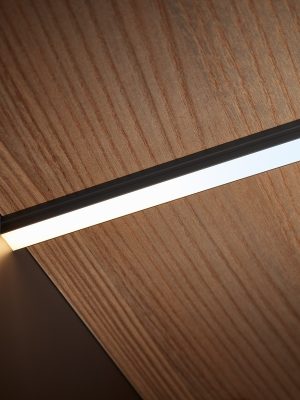Have you ever wondered why in some rooms you feel comfortable and in others you don’t seem to feel comfortable and feel that you can’t even see well?
Much of the answer lies in the decoration and in the separation and lighting of spaces. Depending on the room, the needs of the room, and even the décor, you may need to monitor and calculate the lighting you need.
If you are wondering how to calculate the lighting needed in a space, in this article we show you how to do it with a lumen calculator, in a much easier and simpler way than it seems.
What is a lumen calculator and what is it for?
A lumen calculator is a tool that helps you know how much light you need based on the size and use of a room. Lumens measure the total amount of visible light emitted by a bulb or bulbs, and the higher the number, the brighter the light.
Unlike watts (which indicate consumption), lumens are key to assessing luminous efficacy. And they also differ from lux, which indicate the amount of light per square meter.
How to calculate the required lumens
You don’t need to be an engineer or have any technical knowledge to make your own lumen calculator and find out how much light you need at home. Just apply a very simple formula:
Lumens required = square meters of the room × recommended lumens per square meter
For example, if you have a 10 m² kitchen and about 300 lumens per m² are recommended, you will need 3,000 lumens in total.
Factors influencing the calculation
It’s not all about size. These details also have an impact:
- Type of activity: reading, cooking or relaxing do not require the same light.
- Ceiling height: the higher the ceiling, the more lumens you will need.
- Predominant colors: if the walls are dark, they absorb more light.
- Type of luminaire: some diffuse the light, others focus it.
- Amount of natural light: if enough sun enters, you can reduce artificial lumens.
Indicative table of lumens per square meter
Here is a quick guide to give you a general idea:
- Living room: 100-300 lumens/m²
- Kitchen: 300-500 lumens/m²
- Bedroom: 100-200 lumens/m²
- Bathroom: 200-400 lumens/m²
- Study or office area: 400-700 lumens/m².
- Corridors: 100 lumens/m²
- Outdoor: 200-300 lumens/m²
How many lumens you need depending on the room
Each space in the house serves a different function, so the lighting must be adapted. Here is a review by zones:
Living room or lounge
It is a multifunctional place: sometimes you watch TV, sometimes you read or chat. For this reason, the ideal is to combine general light (about 100-200 lumens/m²) with more intense points of light in key areas, such as next to the sofa or on a side table.
Kitchen
You need bright, practical lighting, especially in work areas such as worktops and hobs. Here we are talking about between 300 and 500 lumens/m². And if you have a central island, do not hesitate to reinforce it with direct light.
Bedroom
The ideal is a relaxing atmosphere, without being short of light when you need it. About 100 to 200 lumens/m² is usually sufficient, and you can add softer lights in small tables or reading areas.
Bathroom
In general, between 200 and 400 lumens/m² are recommended. The key is in the mirror area, where it is advisable to have frontal light (not only from above) to avoid annoying shadows.
Office or study area
This is where you really need to fine-tune. You need bright, glare-free light, around 500 to 700 lumens/m². And if you can use a desk lamp with dimmable light, all the better.
Corridors and entrances
These are transit areas, so you don’t need high illumination. 100 lumens/m² is enough to see well without glare.
Terraces and exteriors
It depends on whether you just pass through or use the space for dining or reading. An average of 200 to 300 lumens/m² can work well, and you can rely on LED garlands or solar sconces.
Lighting types and their impact on lumens
The type of light also makes a difference: for example, if you choose LED bulbs, you will be able to direct the light just where you need it. An LED light is not the same as a halogen light, nor is a warm light the same as a cold white light.
General, spot and ambient lighting
- General: the light that illuminates the entire room, such as a ceiling lamp.
- Spot: focuses on a specific area, such as a reading lamp.
- Ambient: create a cozy atmosphere, with indirect or decorative lights, such as LED strips for furniture, on a shelf or in a cabinet.
The ideal is to combine them according to the use you give to the space.
LED, halogen and fluorescent
LED lighting is the most efficient: it consumes less, lasts longer and offers more lumens per watt. Halogens and fluorescents have been falling out of use due to their lower energy efficiency.
Color temperature and visual comfort
Warm light (2700-3000 K) is ideal for living rooms and bedrooms. Neutral or cool light (4000-6000 K) is recommended for kitchens, bathrooms and work areas. It’s not just about how you see, it’s about how the light makes you feel.
In this sense, the LED DUAL is presented as a versatile solution, especially useful in open spaces or small homes, as it allows changing the color temperature without sacrificing visual comfort. This dual functionality is very advantageous for adapting the lighting to different times or needs of the day.
Step-by-step guide: how to use your own lumen calculator
If you want to try the lumen calculator method, all you have to do is follow these steps:
- Measure well the square meters of the room.
- Define the main use of the space (relaxing, working, cooking…).
- Consult the table of lumens per m².
- Multiply the m² by the recommended number of lumens.
- Check the bulbs you have or need to install and add their lumens.
Why rely on a lumen calculator?
Because it helps you make decisions based on real data, not intuition. Getting the amount of light right:
- Improves visual comfort and prevents eye fatigue;
- It helps you to create more pleasant environments;
- It reduces energy consumption and, therefore, the energy bill;
- Extend the life of your bulbs by using them well.
Choose lumens wisely and gain in comfort and efficiency
Having good lighting at home is not only a matter of taste: it is also a matter of health, savings and well-being. Using a lumen calculator, even a homemade one, allows you to find the exact amount of light needed for each room.
And with that, you will not only see better, you will also feel better. And if you need more ideas or inspiration you can consult our blog, news, trends and much more for your home renovations and our catalog with the most elegant and innovative lighting.






































